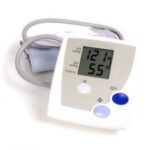Experts have said for a long time that high blood pressure is a silent killer because this condition is often symptomless. Well, there is another condition which is a silent threat too, and it is called fibromuscular dysplasia (FMD).
About 85% of fibromuscular (FMD) sufferers are women, and it is not an old persons disease, as it targets the young as well as the old. The typical age range is between the age of 15 to 60. It is a silent threat because while the arteries are growing abnormally, there is generally no pain or symptoms involved. And worse yet, it seems that many primary care physicians don’t seem to be aware of this condition.
When arteries grow in this abnormal way, they resemble a string of beads, one piece being narrowed followed by an enlarged part of the artery. These abnormalities can occur anywhere in the body, but 75% of the time it is in the kidneys. The problem is that unless these beaded arteries happen to show up in routine testing, such as CT scans, you won’t even know you have them.
There are warning signs, but who would ever think that a young girl of 15 or 16 years old would have high blood pressure and ringing in the ears because of an artery malformation? Who would ever imagine that a 30 year old woman would be in danger while doing something that is purported to be extremely healthy, which is vigorous exercise?
Exercise doesn’t cause FMD, but in this case, normal heart-healthy and invigorating exercise becomes an FMD sufferer’s greatest risk, and this is why:
*Raising the heart rate increases the stress on the artery walls
*Aggravates the disease by causing fragile arteries to tear
*Leads to stroke
*Leads to heart attack
*Leads to death
Some experts believe that all women that participate in strenuous, vigorous exercise should have their doctor check them for FMD, because if a woman knows she has this condition there are steps she can take to reduce her risk while she is exercising.
Some researchers believe that something is out of whack at the hormonal level, because this disease primarily targets women before their menopausal years. Though estrogen is suspected, no one really knows for sure. The condition can be genetic, but it seems most fibromuscular dysplasia sufferers have no family history connection at all.
Strangely, this disease seems to target women who appear to be in great shape, because they are exercisers. And that is partly the problem. Why should young, healthy women who keep themselves in great shape have any reason to go to the doctor for a disease that causes no obvious symptoms? It seems as if these things just happen sometimes, and nobody knows why.
Since these malformed arteries can appear anywhere in the body, it is anybody’s guess what could happen. In some cases, the narrowed part of the artery can choke off the blood supply and in another case the enlarged part could form into an aneurysm, which could rupture. Depending on where these arteries are, and what particular circumstance you find yourself in, the victims could suffer with a stroke or organ failure.
Most people don’t know there is a problem until they are being rushed to the hospital, however if you are aware of this condition their are warning signs. The warning signs are often determined by where the malformation happens to be in the body, but some possible warning signs are:
*high blood pressure, especially at an early age
*a headache
*a whooshing sound in the ear, accompanied by pain
High blood pressure at an early age is indicative of [the possibility] of having FMD arteries in the kidneys because if the kidneys aren’t getting enough blood they will release hormones to increase the flow, which in turn raises blood pressure. Other signs that the problem might be in the kidneys is getting a headache during exercise and unusual side pain.
A sign that FMD arteries might be in the neck is the whooshing sound in the ears, severe headaches, pain in your neck and shoulder, and stroke symptoms ( loss of vision in one eye, or a one-sided weakness).
If the arteries are malformed at the limbs, abdomen or heart you would experience pain in these areas, as well as unusual shortness of breath , unusual fatigue while active and unusual weight loss.
These symptoms are hard to diagnose because individuals or doctors aren’t usually looking, and these symptoms can be indicative of so many different conditions. Sometimes it has taken years for some people to be propertly diagnosed, and sometimes the diagnosis doesn’t come until after a heart attack or stroke. Sometimes there are no symptoms at all.
People who are diagnosed with FMD are still encouraged to exercise because cardiovascular fitness, keeping weight down and keeping cholesterol low is important. However, the doctor will most likely take strenuous vigorous exercise off of the table. Moderate exercise such as light jogging, light strength training , biking, walking and swimming will most likely be alright.
People who have FMD in their neck will be advised to steer clear of contact sports, heavy weights, vigorous sports of any type and yoga . Since trauma can cause an artery to tear, they will also be advised not to visit a chiropractor or participate in any activities that strain the neck (such as roller coasters for instance).
If you or your children participate in strenuous vigorous exercise it might be wise to ask your doctor to check for fibromuscular dyplasia (FMD). Screening for FMD can be challenging because the condition could be anywhere in the body. However to screen for the two most common areas, the kidneys and the neck ask the doctor to:
*check for high blood pressure
*the bruit test (broo-ee). This test checks for disrupted blood flow, however this test is not normally performed on young people, so you may need to ask.
The good news is that if you don’t have high blood pressure, and if the sound from the bruit test sounds normal, you most likely do not have FMD. If your blood pressure is high (140/90 or higher), and there is no family history, ask the doctor to continue looking. The doctor may believe that the numbers are just naturally higher, but if you would rather be safe than sorry, ask him to double check.
If the bruit test has a whooshing sound ask for an ultra-sound, which thankfully, could turn out to be just normal arteries making a sound.
For FMD the treatment consists of controlling the risk factors, such as:
*keeping blood pressure under control through medication and lifestyle changes
*taking an aspirin daily to thin the blood which will prevent small clots from forming on the beaded areas.
*In advanced cases Doctors may enlarge the arteries through angioiplasty, prop them open with stents, or surgically clip an aneurysm so that it won’t burst.
There is no way to stop FMD, because no one knows what causes it. There is no cure, but there are ways to manage it with help from your doctor and support from the Fibromusclar Dyplasia Society of America. When we are diagnosed with a condition, and told there is no cure, it is frightful and distressing, so it is a time for family and friends to reach out in support of their loved ones.
http://www.mayoclinic.com/health/fibromuscular-dysplasia/DS01101
http://www.fmdsa.org/about_fmd.html
http://www.ninds.nih.gov/disorders/fibromuscular_dysplasia/fibromuscular_dysplasia.htm



